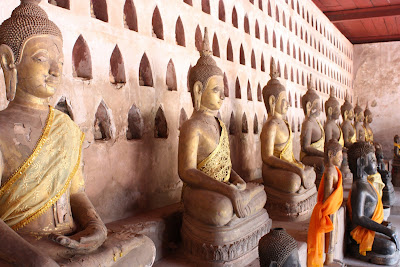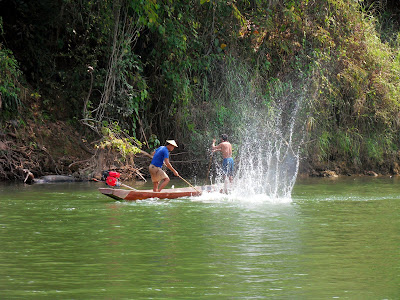
Dongsan High School is with us this week. A Christian specialist school, it's considered among the top five schools in Korea, and every year, they send their freshman students for a week at English Village, before they even start proper school. It's a chance for freshmen to get to know each other, form relationships, do a bit of teambuilding, and compete for the clubs and societies that mark this school as different from the average - which consider clubs as a waste of time that distracts students from their studies...
They are a joy to teach. My first day, I'm so used to herding unruly middle-schoolers, my jaw drops when the students walk out of their hotel ahead of me, in two perfect lines, making their way to our homeroom without even being told. I can stalk at the back, talking to two girls, who tell me "We're very excited about this great opportunity to study with real foreigners." Apart from the pristine language, who ever knew English Village students could be so thrilled about studying English!
The lessons are a pleasure; even the lower-level kids are interested, and the high-level ones actually laugh when the teachers joke with them!

On the Wednesday, we're walking them to the classroom when we pass the school teachers' hotel at the bottom of the road. A teacher is watching TV just inside the open door, and one of the girls lets out a scream of delight. Before long, we've lost them all, a crowd of teenagers cheering and clapping as Kim Yu-Na, the country's top figure-skater, takes first place in the initial round at the Winter Olympics. She's not a singer or a society princess, but Yu-Na is more than a celebrity in Korea - kids here worship those who rise above the crowds to excel in anything. When we complain, the girls reluctantly leave the doorway to get back in line, but our headteacher, who's standing nearby, says that it's ok for them to take a couple of minutes to watch the performance, and the smiles on their faces as they run back to see uplifts me. Later, my coteacher plays the full video of Yu-Na's triumphant piece; she's absolutely perfect, slipping along on the ice as if humans were made to move on two razor thin blades.
Each day, a member of the Overseas Class appears holding a bundle of newspapers for the students and teachers. The Overseas Class is an elite group of students fluent in English. The freshmen actually took a test to be considered for this class while at English Village. Because they couldn't be expected to skip any classes or initiation for the exam, it was written at 11pm - and that didn't even raise an eyebrow from my coteacher, who explained that these children, the cream of the crop, have been raised from birth attending English private lessons and piano classes from 7am until midnight in order to give them the chance of attending such a school as Dongsan. The newspaper is impressive, written at EV, rushed back to the school where it's printed on the private printing press they own, and then driven back to EV the following morning for the students to read over the morning break.
It's a bit of an ego trip for English Village. Their newspaper, commenting on the opening day, calls the teachers "of a high quality, and very handsome and beautiful like princes and princesses."


On the other hand, the headline is "Students Meet Foreigners". Yes. As if we were an exhibit in a zoo. Ahem.
On Friday at lunchtime, I'm with a number of teachers in the pizza restaurant in the Village during the freestyle skating, the second and final round. The Japanese and American contestants are awarded decent scores, but not fantastic. Kim Yu-Na comes on. The restaurant has filled with children, teenagers and parents, and one of my colleagues climbs on a table to turn the volume up on the flat-screen; everyone falls silent, the chefs stop clattering, and we all watch Yu-Na effortlessly break her own record to take the gold, 40 points ahead of her Japanese rival. I can't believe that even the young schoolkids, who haven't been herded in by adults but have hurried in of their own accord in time for her display, are absolutely engrossed in the TV, and when Yu-Na's score is announced - clearly so far ahead as to be unbeatable - the restaurant bursts into tears and applause. It's emotional...

My students compete in a debate they've been preparing for all week. My girls have to compete against boys - until now, they've not been allowed to cohabit classrooms with the opposite gender - Dongsan is strictly Christian. Not sure entirely why it's even co-ed... The boys are also terrified, hiding their fear behind jokes and laughing and formal handshakes. They're more fluent, but my girls have much better grammar. The boys win...


I listen to their hard work, and then later, can't believe it when a head teacher tells me I was actually assigned the lowest level class in the school! These kids weren't fluent, by any means, but they were miles ahead of any of my previous students - even better than some of our Korean teachers! Polite, well-behaved, interested, willing to participate, smart, creative... At the closing ceremony, I eye their foreign English teacher, wondering if he's going to be leaving the job anytime soon - for these kids, I'd return to Korea.















































